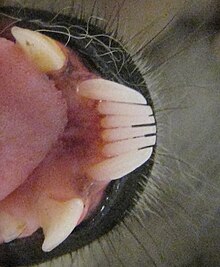Lemurs
- Lemurs are only found in Madagascar, an island that flourishes with tropical forests, dry forests and wet lands.
- Lemurs have a dentition of 3 premolars and molars, 2 incisors, and 1 canine, with a dental formula of 2133.
- Prosimians have what is called a toothcomb, which is six of their teeth including incisors and canines that are closely pushed together. The structure of the teeth actually look like a comb .Fruit eating lemurs use their toothcomb for picking out seeds from their fruit and cut through tree bark for sap. Leaf eating lemurs usually have little toothcomb, showing adaptation to the food selection in their own environment.
Spider Monkey
- Spider monkeys live in tropical rain forests in south Mexico, Bolivia and in Brazil. These tropical rain forests contain the essentials to a spider monkey’s diet which consists of leaves, fruits, insects and flowers.
- Spider Monkeys have a dentition of 3 premolars and molars, 2 incisors, and 1 canine, much like the lemur, with a dental formula of 2133.
- These fruit eating primates use their incisors to pick fruit of trees, and then use their canines puncture the fruit and their molars to chew it.
Baboon
- Baboons have proven to adapt to many different environments such as savannahs, woodlands, grasslands and rocky hill countries. They can be found in Ethiopia, Saudi Arabia and Yemen among different places. They sleep on tall cliffs or trees, and prefer being close to water and food, but can survive for long periods of time without water by licking the night dew off their own fur.
- Baboons have a dentition of 2 pre molars, 3 molars, 2 incisors and 1 canine. Making the dental formula 2123.
- Baboons mainly eat grass, leaves, and blossoms but sometimes eat fish, hares and other small animals. It is possible that the jaw has adapted to their environment by providing a dentition that allows for an omnivorous.
- Gibbons live in tropical and subtropical rain forests in southeast Asia including parts of southern China.
- Gibbons have a dentition of 2 pre molars, 3 molars, 2 incisors and 1 canine, with a dental formula of 2123.
- Gibbons mostly consume fruit which is widely available in their environment. It is reasonable to believe their teeth have adapted in favor of the consumption of large quantities of fruit, making it easier to digest.
Chimpanzee
- Chimpanzees can be found in rain forests and savannahs in Africa.
- They have 2 pre molars, 3 molars, 2 incisors and 1 canine, making their dental formula 2123 like the gibbons and baboons.
- Since the Chimpanzee’s diet contains a very wide variety of food, ranging from plants to small animals, their dentition has adapted to serve the needs of eating both plants and fruits, and animals.
Through the study of these primates dentition patterns one can conclude that the environment and food supply make a direct impact on a primates dental structure. Lemurs and Spider Monkeys share the same dental formula 2133, which directly relates to their similar environment and fruit eating habits. The Baboon, Gibbon and Chimpanzee share the dental formula 2123, and all three share a close environment and food choice as well. The environment has a profound effect on the physical traits of an animal.










Wow! This post really got me thinking!I wonder if the teeth and structure of the mouth of these primates had to have been adapted to by what food sources were available to them, or if they pick and choose their meals by their teeth? I knew absolutely nothing about apes or monkey's teething structures but your post was very impressive and contained alot of knowledge!!
ReplyDeleteGreat images!
ReplyDeleteAre there any other differences in the dentition other than the number of premolars? While all of the primates discussed are omnivores, there diets are all different. If their environment does influence their dentition, wouldn't there be other differences? Like tooth size, cusp height, jaw shape? Baboons have a sectorial premolar. Why? A exploration beyond dental formulas was needed.
I really like your post. You were very detailed. I also liked how you named the trait at the top. It made it much easier to read the blog. I also really like your pictures.
ReplyDeleteI think it's interesting how small mutations over a large amount of time can produce a set of teeth as different as lemurs' and humans' from the same ancestor. It's dizzying to see the effects of such vast amounts of time and know their causes.
ReplyDelete